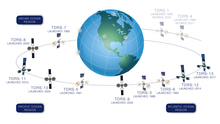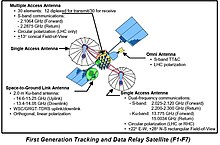Space Network
Space Network (SN) is a NASA program that combines space and ground elements to support spacecraft communications in Earth vicinity. The SN Project Office at Goddard Space Flight Center (GSFC) manages the SN, which consists of:[1]
- The geosynchronous Tracking and Data Relay Satellites(TDRS),
- Supporting ground terminal systems,
- The Bilateration Ranging and Transponder System(BRTS),
- Merritt Island Launch Annex(MILA) relay,
- Network Control Center Data System(NCCDS).
Satellite generations



The space segment of the SN consists of up to six operational relay satellites in geosynchronous orbit. These
All first-generation TDRSs (F1–F7, also known as TDRS A–G) carry functionally identical payloads and all second-generation TDRSs (F8–F10, also known as TDRS H–J) carry functionally identical payloads.[citation needed]
A third generation, TDRS K, L, and M were launched between 2013–2017.
The figures identify the pertinent communications components and associated parameters of the orbiting relay platforms.
Coverage
For spacecraft operating in a
Network Control Center Data System
The Network Control Center Data System (NCCDS) is an element of the SN ground segment.
The NCCDS issues Network Advisory Messages (NAMs) to provide up-to-date information on network conditions and constraints. These messages are accessible via the NCCDS active NAM web site. The
See also
- Deep Space Network
- Near Earth Network
- Indian Deep Space Network
- Tracking and Data Relay Satellite
- Eastern Range
- SCaN Program
References
- ^ NASA, Exploration and Space Communications Projects Division; Goddard Space Flight Center (August 2007). Space Network User's Guide (SNUG), 2.3.2.1, Dedicated Ground Elements (Rev 9 ed.). National Aeronautics and Space Administration. 450-SNUG.
- ^ NASA, Exploration and Space Communications Projects Division; Goddard Space Flight Center (August 2007). Space Network User's Guide (SNUG), 1.1.2, Scope, and 2.3.1.2, TDRS Line-of-Sight Coverage (Rev 9 ed.). National Aeronautics and Space Administration. 450-SNUG.
- ^ Space Network User's Guide (SNUG), 450-SNUG, Rev 9.
